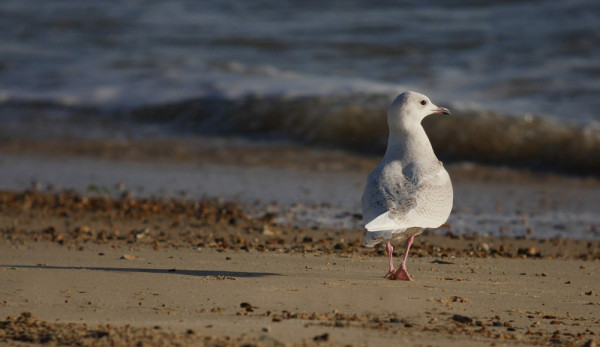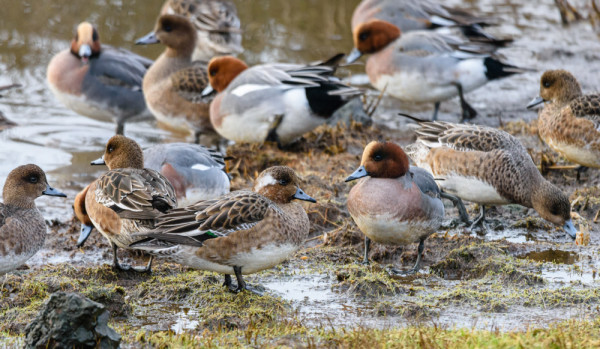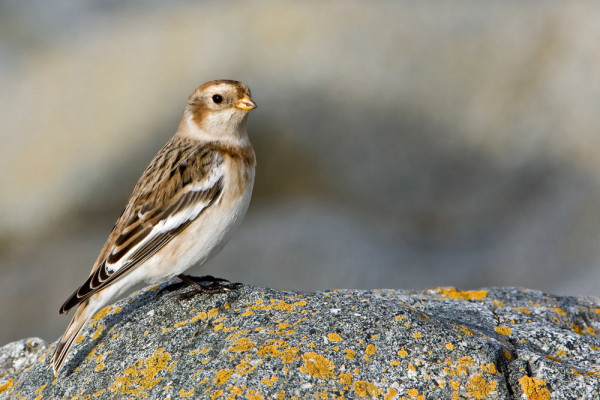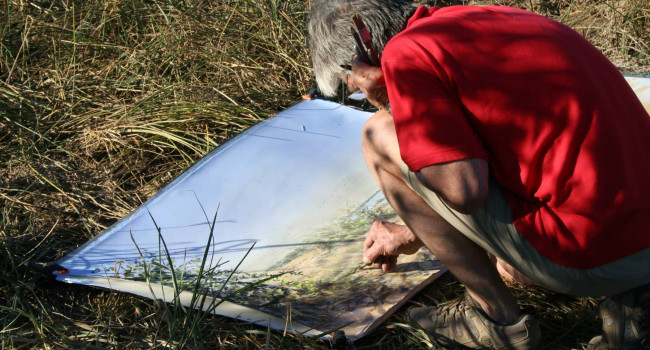
BirdTrack migration blog (mid-December - mid-January)
Scott’s role includes the day-to-day running of BirdTrack: updating the application, assisting county recorders by checking records and corresponding with observers.
Relates to projects
With plummeting temperatures across Britain and Ireland, there is little doubt that winter has arrived - and although the main migration periods are over for this year, the recent icy conditions have resulted in some cold weather movement.
As is typical for this time of year, and these frozen weather conditions, Woodcock has been widely reported. The reporting rate is likely to have increased in part because of the frosty white backdrop, which makes spotting these cryptically plumaged birds a bit easier. However, numbers of Woodcock in the UK have probably increased during the very cold period. The weather patterns that resulted in temperatures plummeting across Britain and Ireland were also responsible for freezing temperatures across Europe; this can push Woodcock wintering in Europe across the North Sea to the UK in search of slightly warmer conditions.
BirdTrack reporting rate for Woodcock in 2022 compared to previous years. There has been a sharp rise in records recently, above the average for this time of year.
The recent cold spell has seen some other species seeking out warmer conditions, and foraging for the food put out for them in our towns and cities. Flocks of Redwing and Fieldfare have taken advantage of the many fruiting trees and shrubs in our urban areas, and the last week has seen an increase in reports of both species to BirdTrack.

The predicted Waxwing invasion hasn’t really materialised, though, with only a scattering of flocks spread across the country. The largest groups recorded so far have been around Elgin, Moray, Nairn and Aberdeen where flocks of around 80 individuals have been seen. In true “Waxwing invasion” years, these flocks have been in the hundreds, so there is a little way to go.
White-fronted Goose numbers continued to build from the end of November as birds arrived from Russia. “White-fronts” typically arrive later than both Pink-footed and Brent Geese, which mainly arrive from late September onwards.
As with Brent Geese, there are two races of White-fronted Goose that winter here: Greenland and European (sometimes known as Russian). As their name suggests, Greenland White-fronted Geese spend the summer months in Greenland, arriving in western Scotland and Ireland for the winter. European White-fronted Geese breed in north-east Russia, travelling across Eurasia to winter in southern and eastern England.

Surprisingly, given the cold weather and the northerly wind, both Iceland and Glaucous Gulls were under-reported - barely 20 individuals of each species were noted in the last couple of weeks. At this time of the year, counts are usually at least double this, and as yet there is no indication as to what could be the cause of the lower numbers.
Even in the depths of winter, there is usually a rare bird to be found and this year is no exception, with the first Stejneger’s Scoter to be recorded in Britain taking the top spot. This Asian relative of the more familiar Velvet Scoter has long been predicted to turn up on our coastlines, as records from elsewhere in northern Europe have increased in the last few years.
Other rarities included a Black-throated Thrush in Lothian, the returning Double-crested Cormorant in Leitrim, a handful of Hume’s Warblers, and a Hooded Merganser in County Mayo.
Looking ahead

As always, the weather will have the biggest impact on what species are likely to be seen over the next month. A cold winter period with several days of freezing temperatures will force many species to either flock together or seek out frost-free areas in search of food.
Waterbirds are often the most heavily impacted: as waterbodies freeze over, the ice blocks access to the food the birds need. During prolonged sub-zero temperatures, birdwatching at any open water, such as larger reservoirs or even estuaries, can be very rewarding.
Diving ducks such as Pochard, Tufted Duck, Scaup, and Goldeneye will flock together, and groups of these birds are always worth scanning for scarcer species like Smew, Ring-necked Duck, or Lesser Scaup. Don't forget to enjoy the large flocks of dabbling ducks as well, like Wigeon, Teal and Pintail.
Look out for Bittern and Water Rail, too, which are often driven out of their reedbed homes during extended periods of cold weather, searching for food and water. Even small reedbeds can be host to these species, and it is not unheard of for Water Rail to be found in gardens where they will take advantage of food put out for more traditional garden birds.

Taiga Bean Goose is one of the last goose species to arrive for the winter. In recent years, the UK’s wintering population has declined markedly, and it has become a difficult species to see. Visiting the Slamannan Plateau near Falkirk - their traditional wintering site - gives you the best chance, but it is always worth checking flocks of grey geese in case a stray bird has joined the group.
Mixed finch flocks are also a feature of winter, and are well worth seeking out. These flocks can contain a range of species including Chaffinch, Greenfinch, Linnet, Goldfinch, and Yellowhammer. Other birds such as Reed Bunting, Corn Bunting, and Tree Sparrow will also join these flocks, sometimes in big numbers. You might even be lucky enough to find a rare species, such as Little or even Pine Bunting.
Look out for winter thrushes like Redwing and Fieldfare, particularly during periods of snow cover. These species will turn up in our gardens as they seek out the berries of ornamental shrubs. Putting out old, soft apples is a good way of attracting them if you don’t have any berry bushes. Providing for thrushes also gives you the best chance of drawing in any Waxwing to your garden.

It might sound strange, but even during mild winters, sewage works can be a great place to look for birds during the winter. Many insect-eating species will take up residence, taking advantage of the slightly warmer temperatures and the abundance of insects found on filter beds. Look out for Chiffchaff, Grey and Pied Wagtail, and Goldcrest; Rock Pipit, Siberian Chiffchaff, and even Yellow-browed Warbler are also possibilities.
If you do feed your garden birds during the winter keep an eye out for wintering Blackcap; increasing numbers are wintering each year in Britain and Ireland and this species will take advantage of a range of foods including suet blocks, apples, and mealworms. Make sure you keep your feeders well-cleaned, following good garden feeding hygiene, and don’t forget to provide fresh water too.
Read more about garden feeding hygiene.
Add your records to BirdTrack
Have you been birdwatching during the cold weather? Don't forget to let us know what you've found.
Adding your records to BirdTrack is quick and easy and gives us valuable information about bird migration.
Find out more








Share this page